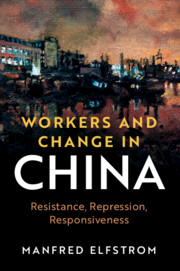Book contents
- Workers and Change in China
- Cambridge Studies in Contentious Politics
- Workers and Change in China
- Copyright page
- Dedication
- Contents
- Figures
- Maps
- Tables
- Acknowledgments
- 1 Introduction
- 2 Recipes for Resistance
- 3 Bureaucratic Incentives
- 4 Orthodox Control
- 5 Risk-Taking Control
- 6 Increased Repressive and Responsive Capacity
- 7 Bottom-Up versus Top-Down Change
- 8 Conclusion
- Appendices
- References
- Index
- Series page
8 - Conclusion
Published online by Cambridge University Press: 14 January 2021
- Workers and Change in China
- Cambridge Studies in Contentious Politics
- Workers and Change in China
- Copyright page
- Dedication
- Contents
- Figures
- Maps
- Tables
- Acknowledgments
- 1 Introduction
- 2 Recipes for Resistance
- 3 Bureaucratic Incentives
- 4 Orthodox Control
- 5 Risk-Taking Control
- 6 Increased Repressive and Responsive Capacity
- 7 Bottom-Up versus Top-Down Change
- 8 Conclusion
- Appendices
- References
- Index
- Series page
Summary
In the years since the second round of protests at Xing Ang and Xing Xiong described at the outset of this book, the situation in Dongguan has continued to evolve. With revenue slowing, Stella International finally closed Xing Ang in 2016 (while leaving Xing Xiong in operation). The company has since promised to “selectively reduce production capacity in China in order to improve utilization efficiency and deliver margin recovery over the medium term” (World Footwear 2018). This will likely mean more orders being directed to Stella’s facilities in Vietnam and Indonesia. And the Taiwanese shoe giant is not alone: with rising Chinese wages, more and more businesses are rerouting their supply chains abroad (Interview 82). Meanwhile, retail and finance are making inroads into the Pearl River Delta’s sweatshop wasteland. A scan of Baidu Maps shows that a luxury mall with foreign clothing stores and a Pizza Hut has opened next door to the old Xing Ang plant. Dongguan’s train station, previously bustling, can be surprisingly empty now – as can the wide roads around it. Old factories are turning into warehouses for e-commerce companies or standing empty with signs for rent. Migrants are staying in the countryside, waiting for an uptick, or finding jobs in firms that have moved inland, closer to their homes (Group Interview 114). The COVID-19 pandemic has, of course, dampened industrial activity further. There is a feeling that an era of intense movement in Chinese labor relations is drawing to a close, and it is not clear what lies ahead.
Information
- Type
- Chapter
- Information
- Workers and Change in ChinaResistance, Repression, Responsiveness, pp. 146 - 166Publisher: Cambridge University PressPrint publication year: 2021
